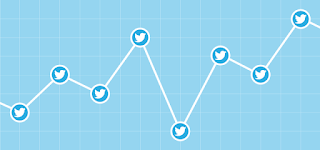There are a set of primary Twitter
metrics every social media marketing specialist, more
with any startup
enterprise, should be tracking. Even early measurement programs can benefit
from a few simple metrics, for the Twitter metrics that matter. And indeed,
they are very much encouraged to be monitored.
The first, and easiest, social
media metric to measure is Volume.
Volume is a great initial indicator of interest. People tend to talk about
things they either love or hate, but rarely talk about things they simply don’t
care about, at all. While volume can seem like a simple counting metric, there’s
more to it than just counting tweets and retweets. It’s important to measure
the number of tweets about your brand, “Mentions”
of your account and “Unique People”
talking about you. Track how these numbers change over time and look for spikes
outside the normal range, like if there was a cause that triggered an increase
or if there are days or times when more people seem to be talking about your
brand. Use this information to post more during these times to increase
engagement.
Reach measures the spread of a social media conversation and can
help you understand the context for your content. How far is your content
disseminating? How big is the audience for your message? Reach is a measure of
potential audience size, showing you how many people could have seen your
tweets. The larger the reach, the more different people talked about a topic. A
high reach indicates a diversity in contributors, some of them potentially
influential.
A large audience is good, but reach
alone does not tell you everything. Reach becomes very powerful when compared
to other engagement metrics. Use reach as the denominator in your social media
measurement equations. Pick important action or engagement numbers like clicks,
retweets or replies and divide them by reach to calculate an engagement rate.
Of the possible audience for your campaign, how many people participated? Reach
helps contextualize other metrics so you can better understand impact.
Engagement is one of the most important areas to measure in social media
networking, like how people are participating in the conversation about
your brand, what they do to spread your content and engage with the topic. On
Twitter, content can be both shared and replied to. Twitter retweets are
helpful to know who spreads your content, while replies and mentions show who
engages with your content, and favorite tags show who likes it.
Think carefully about your social
goals and the kinds of engagement you’re interested in measuring. Measuring
spread or amplification is important to know how far your message reaches
beyond your direct audience. Measuring interaction helps you know which content
is resonating and informs future content strategy. Find metrics that reflect
what’s important to your particular needs. Measure your efforts to learn what
works and what doesn't. Tweet, measure, adjust and repeat.






0 comments:
Post a Comment